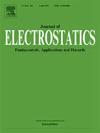A novel algebraic topological method-based approach for evaluating stored electrostatic energy and 3D Maxwellian capacitance
IF 1.9
4区 工程技术
Q3 ENGINEERING, ELECTRICAL & ELECTRONIC
引用次数: 0
Abstract
This paper presents a new and first of its kind approach for numerical evaluation of stored electrostatic energy and capacitance using Algebraic Topological Method (ATM). The ATM is an alternative computing technique with certain advantages over conventional methods such as Finite Difference Method, Finite Element Method, and Method of Moments because it can formulate Multiphysics problems using direct discrete forms instead of partial differential equations. As a proof of concept, the approach has been validated in ideal 1D, 2D and 3D capacitors and the relative error was found to be <1 % when compared with corresponding analytical solutions. Further the problems of capacitors with simple 3D geometries were solved and the relative error found to be <3 % using refined mesh. The numerical stability of the proposed approach for different mesh sizes is investigated and the effect of modeling space is also studied in detail. Finally, the applicability of ATM is benchmarked with the Finite Element Method and experimental results in the case of real capacitors used in engineering applications. The results show that the proposed approach holds great potential for advancing the field of capacitor devices design and optimization by means of modeling and virtual prototyping.

一种基于代数拓扑方法的计算存储静电能量和三维麦克斯韦电容的新方法
本文提出了一种新的、首创的利用代数拓扑法(ATM)对静电存储能量和电容进行数值计算的方法。ATM是一种替代计算技术,与有限差分法、有限元法和矩量法等传统方法相比,它具有一定的优势,因为它可以使用直接离散形式而不是偏微分方程来表述多物理场问题。作为概念验证,该方法已在理想的1D, 2D和3D电容器中进行了验证,与相应的解析解相比,发现相对误差为<; 1%。进一步解决了具有简单三维几何形状的电容器的问题,采用精细化网格计算得到的相对误差为3%。研究了该方法在不同网格尺寸下的数值稳定性,并详细研究了建模空间的影响。最后,以实际工程应用的电容器为例,用有限元法和实验结果对ATM的适用性进行了基准测试。结果表明,该方法在通过建模和虚拟样机技术推进电容器器件设计和优化方面具有很大的潜力。
本文章由计算机程序翻译,如有差异,请以英文原文为准。
求助全文
约1分钟内获得全文
求助全文
来源期刊

Journal of Electrostatics
工程技术-工程:电子与电气
CiteScore
4.00
自引率
11.10%
发文量
81
审稿时长
49 days
期刊介绍:
The Journal of Electrostatics is the leading forum for publishing research findings that advance knowledge in the field of electrostatics. We invite submissions in the following areas:
Electrostatic charge separation processes.
Electrostatic manipulation of particles, droplets, and biological cells.
Electrostatically driven or controlled fluid flow.
Electrostatics in the gas phase.
 求助内容:
求助内容: 应助结果提醒方式:
应助结果提醒方式:


